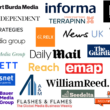AgriBriefing, the food and farming information business, has been sold to the private equity-owned Mintec for a price believed to be £175mn (an estimated 15x EBITDA).
Mintec, a UK-based provider of price data, analytics, and forecasts for agri-food, was itself sold for £210m (32x EBITDA) last year. It said that the acquisition of AgriBriefing (including the brands Urner Barry, Strategie Grains, FeedInfo and the just-acquired Tropical Research Services) creates “the largest agri-food-focused Price Reporting Agency (PRA) with feed-to-food commodity prices, forecasts, cost modeling tools and fundamental market data, serving over 5,000 customers in 50 countries”. The US-based Urner Barry claims to have been a pioneer agri-food PRA, founded in 1857.
The deal marks a spectacular 10-year finale for the founders of AgriBriefing which had been launched in the UK as Briefing Media, by B2B media executives Neil Thackray (ex RELX, UBM), Rory Brown (Metal Bulletin, Incisive) and Rupert Levy (Haymarket, UBM). Brown has been CEO and Levy CFO. In 2012, they paid the former UBM some £10m for Farmers Guardian and the medical weekly Pulse. They eventually became a food-farming specialist after flirting with the medical and media markets.
Their strategy delivered – courtesy of the 179-year-old Farmers Guardian which pushed up revenue by 57% and profit by 27% in its first four years. The energetic success was consolidated by acquisition of the 40-year-old LAMMA machinery show and the launch of CropTec for arable farming. Then came the climb up the value chain with the coveted PRAs, notably in France and the US. But the UK company failed, in 2019, to achieve its dream deal of becoming a global information leader – by merging with Informa’s then AgriBusiness division and Kynetec, the £77m-revenue UK-based, agriculture research specialist. The three-way deal foundered partly on what the other parties considered to be AgriBriefing’s low-grade UK earnings (ie the print-centric Farmers Guardian).
In 2021, AgriBriefing’s latest private equity owners took the hint and divested their UK business for a sweet £19.3m (10x EBITDA) to the hungry EagleTree-backed startup Arc Media Holdings. The sale was accompanied by upbeat assertions that AgriBriefing would now be generating some 80% of its revenue from subscriptions and would focus on its global pricing, analytics, forecasting, and consulting “which provide proprietary data and intelligence on the estimated US$5tn global trade in agricultural commodities, food and biofuel”.
In 2019, the company’s majority owners Horizon Capital, of the UK, and Ares Management, of the US, together valued AgriBriefing at £123m, ie c£100m after divestment of the UK subsidiary.
This week’s AgriBriefing sale (and also the recent spin-off of Fastmarkets from the Euromoney buyout) highlights the soaring values of PRAs and their subscription-led revenues. PRAs are highly attractive because they become the “official” prices which govern trading in the world’s commodity markets. They are the exclusive information sources which facilitate transactions and also revenues from consulting and high-value research.
PRAs are said to have begun even before Urner Barry started in the US. But they were transformed when the energy journalist Warren Platt launched National Petroleum News in 1909. He was in the right place at the right time, Ohio where John D. Rockefeller had established Standard Oil. Platt spotted a hunger for information about the oil sector and he borrowed $2,500 to set up his monthly magazine, aiming to level “the information playing field between independent oilmen and Big Oil by promoting transparency within the industry”. Two years’ later, the US Supreme Court ordered the breakup of Standard Oil’s monopoly. The demand for information exploded.
Warren Platt’s Oilgram newsletter (launched in 1923 and still published today) provided up-to-date independent data on pricing to oil companies. His business (acquired by McGraw Hill in 1953) on the world’s most valuable bulk commodity has defined how PRAs have operated ever since. As an informative history of PRAs** says: “The first PRAs mostly started as mailed or faxed newssheets prepared by small teams of specialist commodity journalists. Publishing price assessment was an important element of their reports but was not necessarily the dominant business driver that it is today. Most started as journalistic enterprises and so provided news about market developments and company activities as well as analysis of price trends.”
But PRA journalists and their close relationship with the commodity markets on which they report has sometimes created potential conflicts of interest – and questions about the independence of price information. The methodology for assessing prices is key, of course, and quite different to journalistic news gathering. But the largest PRAs combine them in a single business model which poses obvious efficiency questions in the era of AI and big data.
Tom Braithwaite, a senior editor of the Financial Times (who once worked for Platts), has written: “Some years ago I worked for a company that publishes commodity prices. I would phone gas traders who would give me a list of trades. I would enter them in a spreadsheet that spat out a magic benchmark. I hope that my amiable gas traders always told the truth and the full truth but I have no way of knowing.”
What is unarguable is that PRAs are increasingly valued in the energy, metals and agricultural markets, and ever more widely. The trend is being turbocharged by M&A prices (like that paid for AgriBriefing). That’s why we’re all increasingly aware of the existing and potential scale of PRAs, some of which had previously been bought and sold for a fraction of the recent multiples. There are said to be more than 100 PRAs providing benchmarks across the world, generating more than 100,000 price assessments every week with the largest publishing thousands of prices every day in a wide range of commodity markets.
Today, Platts is a dominant $1bn business. It generates some 12% of the $8bn-revenue S&P Global but accounts for 50% of the $2bn global PRA market mainly in oil but also across energy, shipping, chemicals, metals and agriculture. Its close rival – in what some insiders suggest is a cosy duopoly – is the $300m-revenue, UK-based Argus Media. It was launched in 1970 by a former UK government official and Reuters journalist Jan Nasmyth whose Europ-Oil prices report was just in time to exploit the price mayhem of the 1973 Arab oil embargo. He understood that the real oil market operated beyond the grasp of the multinational companies and Opec, both of which tried to control the price for their own ends.
Nasmyth renamed his newsletter Petroleum Argus and, in 1979, began publishing daily spot prices for crude oil in competition with Platts – just as the Iranian revolution again sent oil prices into turmoil.
Argus Media – which owns pricing indices across energy, metals, petrochemicals and coal but also operates in agriculture, fertilisers, power and transportation – is the world’s second largest PRA provider. In 2016, General Atlantic (GA) private equity acquired a 52% shareholding in a deal which valued Argus at $1.5 bn. GA has since sold down its shareholding to Hg Capital and others. It is believed that the chair-CEO Adrian Binks now owns almost 50% of Argus which may be worth up to $2.5bn.
The principal PRA companies – together accounting for an estimated $1.7bn of revenue (mostly with 40-50% EBITDA margins) – are:
| Price Reporting Agencies | Est revenue | Owner |
| 1. Platts | $1bn | S&P Global |
| 2. Argus Media | $300m | Private equity |
| 3. ICIS | $150m | RELX |
| 4. OPIS | $130m | News Corp |
| 5. FastMarkets | $100m | Private equity |
ICIS (originally Independent Chemical Information Services) was launched in 1979 by a former Argus Media reporter and then sold to Reed Elsevier (now RELX) which merged it into the data weekly European Chemical News. ICIS owns the majority of the major benchmarks in petrochemicals and competes directly with Platts in Europe and Asia. Topically, it has a dominant position in European pipeline gas.
Last year, News Corp acquired the US-based Oil Price Information Service (OPIS) from IHS Markit for $1.2bn (18x EBITDA). The provider of benchmark pricing, news and analytics for the energy industries is now part of the Dow Jones Professional Information Business, which includes Dow Jones Risk & Compliance, Dow Jones Newswires and Factiva. It was said to be “the cornerstone for a rising commodities, energy and renewables digital business”. The 46-year-old OPIS had pioneered wholesale crude price discovery. As part of the deal, Dow Jones also acquired the Coal, Metals and Mining (CMM) and PetroChem Wire businesses. The acquisitions – ahead of IHS Markit’s acquisition by Platts’ parent S&P Global – had been inevitable because Platts’ own proposed acquisition of OPIS had been thwarted by US customers on competition grounds a decade earlier.
In some ways, the new PRA major – and one expected to grow through acquisition in the next few years – is FastMarkets, the Euromoney division spun-out as a result of the £1.6bn private equity purchase of the listed parent. It last year accounted for 25% of Euromoney revenue and 31% of EBITDA. FastMarkets itself had grown out of Metal Bulletin (acquired by Euromoney for £200m in 2006). It was a PRA pioneer launched in 1913 as a spin-off from The Ironmonger magazine, using prices from the London Metal Exchange.
The development of these PRA companies underlines their traditional media role. But one UK-based startup is challenging what it sees as a confict between journalism and data capture. General Index (GI) has been launched by Neil Bradford, former CEO of Argus Media, as a tech-based disrupter of PRAs, believing that the cable TV-like bundling of commodity prices and news coverage may be neither good for the value nor the probity of many PRAs. The London-based GI has $9m of funding and employs 40 people. Bradford knows the market well and makes a good case but it’s a challenging business to break into. He is encouraged by the expansion of PRAs but even more so by the continuing dominance of oil. For all the moves away from hydrocarbons in some developed economies, oil demand is still growing worldwide and may not peak until 2030; even then, the actual decline is expected to be slow. Oil will be important to PRAs and vice versa for a long time yet – which might, of course, encourage increased regulation.
The current price pressures in gas markets may intensify the official oversight of PRAs which have periodically been in the sights of European Union and other regulators. Perhaps that and the sheer level of profitability among PRAs will also encourage General Index and others offering a service provided more by technology than journalists. But history – and the dominance of Platts for the past 113 years – indicates that any substantial change may be slow.
But what has really shone a light on the arcane world of PRAs is the realisation that the growth of international trade and of new energy sources and processes is turbocharging profits, boosting information services and providing high profit margins from the best revenue stream of all – subscriptions. It’s all at a time when it is clear that news – however specialist – is of relatively low value; data is gold.
That’s why a host of ‘new’ companies including Mintec, AgriBriefing, Commodities Research Unit (CRU), Wood Mackenzie and many others are pushing strongly into price benchmarking and chasing the juicy profit margins of the PRA leaders. They too will be applauding the brilliant success of the relatively small AgriBriefing. The one-time ‘ordinary’ B2B publisher, dependant on the newsstand sales of a weekly newspaper, morphed – in a few short years – into a $350m/ £350m PRA business. It’s been a journey from B2B news solely in the UK, through events, to financial information and then pricing on a worldwide basis; from print advertising to high-priced digital subscriptions. Pow!
It’s a success story that Rory Brown’s peers should also study carefully. B2B media companies – whether primarily in news, information or events – should focus on the fact that their customers in verticals where there are many suppliers and end-users will pay handsomely for reliable, independent data on prices, costs and ‘traffic’. Their businesses depend on it.
We have commented before on the irony that many of the early ‘trade’ weeklies which dominated vertical B2B sectors in the early 20th century routinely included prices and exclusive statistical indicators as part of their coverage. Some still do. But, for many, the golden days of advertising growth pushed publishers towards high-traffic news. And now, just as the advertising has (mostly) vanished, so have the readers who are prepared to pay for mere news. But, in a world where many competitors are no longer chatty near-neighbours, independent pricing information has never been more valuable. For all the supposed information overload, businesses are hungry for reliable performance data.
Publishers of single-sector B2B brands should search their markets for the data demand that could yet transform them into high-value, long-lasting PRAs – before data specialists beat them to it. There’s gold in prices and an increasing number of companies know it.
**The Price Reporters: A guide to PRAs and Commodity Benchmarks, by Owain Johnson (Routledge, 2017)




